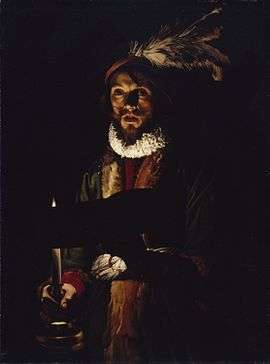Tenebrism
.jpg)
Tenebrism, from the Italian, tenebroso (murky), also called dramatic illumination, is a style of painting using very pronounced chiaroscuro, where there are violent contrasts of light and dark, and where darkness becomes a dominating feature of the image. The technique was developed to add drama to an image through a spotlight effect,[1] and was popular during the Baroque period of painting.
Origins

The artist Caravaggio is generally credited with the invention of the style, although this technique was used much earlier by various artists, such as Albrecht Dürer, Tintoretto, and El Greco. The term is usually applied to artists from the seventeenth century onward. Artemisia Gentileschi, one of the few women artists of the Baroque and a follower of Caravaggio, was an outstanding exponent of tenebrism.[2]
El Greco painted three versions of a composition with a boy, a man, and a monkey grouped in darkness around a single flame. Among the most well-known tenebrist artists are: Italian and Dutch followers (the Utrecht School) of Caravaggio, Francisco Ribalta, Jusepe de Ribera, and their Spanish followers.
17th Century

Tenebrism is most often applied to seventeenth-century Spanish painters. It is sometimes applied to other seventeenth-century painters including Georges de La Tour, who painted many images lit by a single candle, Gerrit van Honthorst, and Rembrandt. In Flanders Adam de Coster was recognized as a leading tenebrist who excelled in scenes in which a single candle has its light blocked by an object.[3]
The term is not often used of Adam Elsheimer, although he was an important innovator in painting night-scenes with a few lighted areas. His dark areas are always full of detail and interest.
Later development
Later, similar compositions were painted by Joseph Wright of Derby and other artists of the Romantic Movement, but the term is rarely used to characterize their work in general.[4]
References
- ↑ Lois Fichner-Rathus (January 2011). Foundations of Art and Design: An Enhanced Media Edition. Cengage Learning. p. 90. ISBN 1-111-77145-6.
- ↑ Thomas Buser (2006). Experiencing Art Around Us. Cengage Learning. p. 89. ISBN 0-534-64114-8.
- ↑ Notes on Adam de Coster at Sotheby's
- ↑ Policarp Hortolà i Gómez (August 2012). The aesthetics of haemotaphonomy : stylistic parallels between a science and literature and the visual arts. Editorial Club Universitario. p. 38. ISBN 978-84-9948-991-9.
External links
| Wikimedia Commons has media related to Tenebrism. |
- More details (below introduction)
- Art Lexicon
- Jusepe de Ribera, 1591-1652, a full text exhibition catalog from The Metropolitan Museum of Art, which includes material on Ribera and Tenebrism